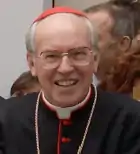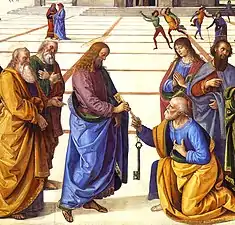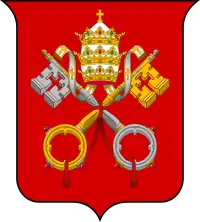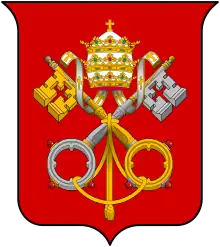Dean of the College of Cardinals
The dean of the College of Cardinals (Latin: Decanus Collegii Sanctae Romanae Ecclesiae Cardinalium) presides over the College of Cardinals in the Roman Catholic Church, serving as primus inter pares (first among equals). The position was established in the early 12th century. He always holds the rank of a cardinal bishop, and is assisted by a vice-dean. Both are elected by and from the cardinal bishops who are not Eastern Catholic patriarchs, with their election subject to papal confirmation. Except for presiding over the college, the dean and vice-dean have no power over the other cardinals. In the order of precedence in the Catholic Church, the dean and vice-dean, as the two most senior cardinals, are placed second and third, respectively, after the pope.

The dean is often, but not necessarily, the longest-serving member of the whole College. It had been customary for centuries for the longest-serving of the six cardinal bishops of suburbicarian sees to be the dean. This was required by canon law from 1917[1] until 1965, when Pope Paul VI empowered the six to elect the dean from among their number. This election was a formality until the time of Pope John Paul II.
In 2019, upon accepting Cardinal Angelo Sodano's resignation as dean of the College of Cardinals, Pope Francis established that the dean would henceforth serve a five-year term that may be renewed once. Sodano received the title "dean emeritus" upon resigning on 21 December 2019.[2][3] In anticipation of the election of Sodano's successor, Francis said: "I am hoping they will elect someone who can carry this important responsibility full time."[4] Previously, the dean held the position until death or resignation; there was no mandatory age of retirement.[5]
Responsibilities
| Part of a series on the |
| Hierarchy of the Catholic Church |
|---|
 |
| Ecclesiastical titles (order of precedence) |
|
|
The dean summons the conclave for the purposes of electing a new pope following a death or resignation. The Dean presides over the daily meetings of the College of Cardinals in advance of the conclave and then presides over the conclave if his age does not prohibit his participation. The dean also has the responsibility of communicating the "news of the Pope's death to the Diplomatic Corps accredited to the Holy See and to the Heads of the respective Nations".[6] He is the public face of the Holy See until a new pope is elected. If he participates in the conclave, the dean asks the pope-elect if he accepts the election, and then asks the new pope what name he wishes to use. If the newly elected pope is not already a bishop, the dean ordains him a bishop.[7]
The dean has "the title of the diocese of Ostia, together with that of any other church to which he already has a title,"[8] such as his suburbicarian diocese. This has been the case since 1914, by decree of Pope Pius X—previous deans had given up their suburbicarian see and taken the joint title of Ostia and Velletri, which were separated in that same 1914 decree.[9]
Deans elected pope
Nine Deans have been elected pope:[10] Anastasius IV, Lucius III, Gregory IX, Alexander IV, John XXI, Alexander VI, Paul III, Paul IV, and Benedict XVI.
List of Deans
The following is the list of Deans of the Sacred College of Cardinals, separated into three groups to account for the Western Schism, which ended after the Council of Constance. The earliest attested reference to the "College of Cardinals" is at the Council of Reims in 1148.[11]
Each name in the following list includes years of birth and death, then comma-separated years of cardinalate and deanship.
Before the Western Schism
- Pietro Senex (d. 1134) (1102, before 1130)[12]
- Guillaume (d. 1137/39) (1122, 1130)
- Corrado della Suburra (1073–1154) (1114, 1137/39)
Elected Pope Anastasius IV in 1153 - Imar of Tusculum (d. 1161) (1142, 1153, deposed 1159[13])
- Gregorio de Suburra (d. 1163) (1140, 1159)
- Ubaldo Allucingoli (1097–1185) (1138, 1163)
Elected Pope Lucius III in 1181 - Conrad of Wittelsbach (1120/25–1200) (1165, 1181)
- Ottaviano di Paoli (d. 1206) (1182, 1200)
- Pietro Gallocia (d. 1211) (1188, 1206)
- Nicola de Romanis (d. 1219) (1204, 1211)
- Ugolino Conti di Segni (1145–1241) (1198, 1219)
Elected Pope Gregory IX in 1227 - Pelagio Galvani (d. 1230) (1206/07, 1227)
- Jean Halgrin (1180–1237) (1227, 1230)
- Jacques de Vitry (1160/70–1240) (1228, 1237)
- Rinaldo Conti (1185–1261) (1227, 1240)
Elected Pope Alexander IV in 1254 - Odo of Châteauroux (1190–1273) (1244, 1254)
- John of Toledo (d. 1275) (1244, 1273)
- João Pedro Julião (1210–1276) (1273, 1275)
Elected Pope John XXI in 1276) - Bertrand de Saint-Martin (d. 1277) (1273, 1276)
- Ordonho Alvares (1198–1285) (1278, 1278)
- Bentivenga de Bentivengi (1230–1289) (1278, 1285)
- Latino Malabranca Orsini (d. 1294) (1278, 1289)
- Gerardo Bianchi (1220/25–1302) (1278, 1294)
- Giovanni Boccamazza (d. 1309) (1285, 1302)
- Leonardo Patrasso (1230–1311) (1300, 1309)
- Giovanni Minio de Murovalle (1250–1312) (1302, 1311)
- Nicolò Albertini (1250–1321) (1303, 1312)
- Berenger Fredoli (1250–1323) (1305, 1321)
- Berenguer Fredol (d. 1323) (1312, 1323)
- Guillaume Godin (1260–1336) (1312, 1323)
- Pierre Desprès (1288–1361) (1320, 1336)
- Élie de Talleyrand-Périgord (1301–1364) (1331, 1361)
- Guy de Boulogne (1313–1373) (1342, 1364)
- Ange de Grimoard (1315/20-1388) (1366, 1373, deposed by Urban VI in 1378, retained the post in the obedience of Avignon until 1388)
During the Western Schism
|
The obedience of Rome (1378–1415)
|
The obedience of Avignon (1378–1429)
|
The obedience of Pisa (1409–1415)
|
After the Council of Constance
 |
| This article is part of a series on |
| Vatican City |
|---|
- Angelo Correr (ca.1330–1417) (1415, 1415)[15]
- Jean-Allarmet de Brogny (1342–1426) (1385, 1417)
- Baldassare Cossa (ca.1360/70–1419) (1419, 1419)[16]
- Jean Allarmet de Brogny (again) (1342–1426) (1385, 1419)
- Angelo d'Anna de Sommariva (d. 1428) (1384, 1426)
- Giordano Orsini (1360/70–1438) (1405, 1428)
- Antonio Correr (again) (1369–1445) (1408, 1438)
- Giovanni Berardi (1380–1449) (1439, 1445)[17]
- Amadeo de Savoy (1383–1451) (1449, 1449)[18]
- Francesco Condulmer (1390–1453) (1431, 1451)[19]
- Giorgio Fieschi (ca.1395–1461) (1439, 1453)
- Isidore of Kiev (1380/90–1463) (1439, 1461)
- Bessarion (1403–1472) (1439, 1463)
- Guillaume d'Estouteville (1403–1483) (1439, 1472)
- Rodrigo Borgia (1431–1503) (1456, 1483)
Elected Pope Alexander VI in 1492) - Oliviero Carafa (1430–1511) (1467, 1492)[20]
- Raffaele Riario (1461–1521) (1477, 1511)
- Bernardino Lopez de Carvajal (1456–1523) (1493, 1521)
- Francesco Soderini (1453–1524) (1503, 1523)
- Niccolò Fieschi (1456–1524) (1503, 1524)
- Alessandro Farnese (1468–1549) (1493, 1524)
Elected Pope Paul III in 1534) - Giovanni Piccolomini (1475–1537) (1517, 1535)
- Giovanni Domenico de Cupis (1493–1553) (1517, 1537)
- Gian Pietro Carafa (1476–1559) (1536, 1553)
Elected Pope Paul IV in 1555) - Jean du Bellay (1492–1560) (1535, 1555)
- François de Tournon (1489–1562) (1530, 1560)
- Rodolfo Pio de Carpi (1500–1564) (1536, 1562)
- Francesco Pisani (1494–1570) (1517, 1564)
- Giovanni Girolamo Morone (1509–1580) (1542, 1570)
- Alessandro Farnese, juniore (1520–1589) (1534, 1580)
- Giovanni Antonio Serbelloni (1519–1591) (1560, 1589)
- Alfonso Gesualdo (1540–1603) (1561, 1591)
- Tolomeo Gallio (1526–1607) (1565, 1603)
- Domenico Pinelli (1541–1611) (1585, 1607)
- Francois de Joyeuse (1562–1615) (1583, 1611)
- Antonio Maria Galli (1553–1620) (1586, 1615)
- Antonio Maria Sauli (1541–1623) (1587, 1620)
- Francesco Maria del Monte (1549–1626) (1588, 1623)
- Ottavio Bandini (1558–1629) (1596, 1626)
- Giovanni Battista Deti (1576–1630) (1599, 1629)
- Domenico Ginnasi (1550–1639) (1604, 1630)
- Carlo Emmanuele Pio de Savoia, seniore (1585–1641) (1604, 1639)
- Marcello Lante della Rovere (1561–1652) (1606, 1641)
- Giulio Roma (1584–1652) (1621, 1652) served less than 5 months
- Carlo de' Medici (1595–1666) (1615, 1652)
- Francesco Barberini, seniore (1597–1679) (1623, 1666)
- Cesare Facchinetti (1608–1683) (1643, 1680)
- Niccolò Albergati-Ludovisi (1608–1687) (1645, 1683)
- Alderano Cybo (1613–1700) (1645, 1687)
- Emmanuel–Theodose de la Tour d'Auvergne de Bouillon (1643–1715) (1669, 1700)
- Nicola Acciaiouli (1630–1719) (1669, 1715)
- Fulvio Astalli (1655–1721) (1686, 1719)
- Sebastiano Antonio Tanara (1650–1724) (1695, 1721)
- Francesco del Giudice (1647–1725) (1690, 1724)
- Fabrizio Paolucci (1651–1726) (1697, 1725)
- Francesco Pignatelli 1635 (1652–1734) (1703, 1726)[21]
- Francesco Barberini (1662–1738) (1690, 1734)
- Pietro Ottoboni (1667–1740) (1689, 1738)
- Tommaso Ruffo (1663–1753) (1706, 1740)
- Pierluigi Carafa (1677–1755) (1728, 1753)
- Rainiero d'Elci (1670–1761) (1737, 1755)
- Giuseppe Spinelli (1694–1763) (1735, 1761)
- Carlo Alberto Guidoboni Cavalchini (1683–1774) (1743, 1763)
- Gian Francesco Albani (1720–1803) (1747, 1774)[22] longest deanship
- Henry Benedict Maria Clement Stuart (1725–1807) (1747, 1803) longest total cardinalate
- Leonardo Antonelli (1730–1811) (1775, 1807)
- Alessandro Mattei (1744–1820) (1779, 1814) vacancy caused by his exile by Napoleon
- Giulio Maria della Somaglia (1744–1830) (1795, 1820)
- Bartolomeo Pacca (1756–1844) (1801, 1830)
- Lodovico Micara (1775–1847) (1824, 1844)
- Vincenzo Macchi (1770–1860) (1826, 1847)
- Mario Mattei (1792–1870) (1832, 1860)
- Costantino Patrizi Naro (1798–1876) (1834, 1870)
- Luigi Amat di San Filippo e Sorso (1796–1878) (1837, 1877)
- Camillo di Pietro (1806–1884) (1853, 1878)
- Carlo Sacconi (1808–1889) (1861, 1884)
- Raffaele Monaco La Valletta (1827–1896) (1868, 1889)
- Luigi Oreglia di Santo Stefano (1828–1913) (1873, 1896)
- Serafino Vannutelli (1834–1915) (1887, 1913)
- Vincenzo Vannutelli (1836–1930) (1889, 1915)
- Gennaro Granito Pignatelli di Belmonte (1851–1948) (1911, 1930)
- Francesco Marchetti-Selvaggiani (1871–1951) (1930, 1948)
- Eugène Tisserant (1884–1972) (1936, 1951)
- Amleto Giovanni Cicognani (1883–1973) (1958, 1972)
- Luigi Traglia (1895–1977) (1960, 1974)
- Carlo Confalonieri (1893–1986) (1958, 1977)
- Agnelo Rossi (1913–1995) (1965, 1986, retired 1993)
- Bernardin Gantin (1922–2008) (1977, 1993, retired 2002)
- Joseph Ratzinger (born 1927) (1977, 2002) Elected Pope Benedict XVI in 2005
- Angelo Sodano (born 1927) (1991, 2005, retired 2019)
- Giovanni Battista Re (born 1934) (2001, 2020)
References
- Acta Apostolicae Sedis (PDF) (in Latin). IX, part II. 1917. p. 50, Canon 237. Retrieved 22 December 2019.
- "A Letter in the form of a "Motu Proprio" regarding the Office of Dean of the College of Cardinals, 21.12.2019". 29 November 2019. Retrieved 21 December 2019. Cite journal requires
|journal=(help) - Senèze, Nicolas (21 December 2019). "Démission d'Angelo Sodano, doyen des cardinaux". La Croix (in French). Retrieved 22 December 2019.
- "Audience of the Holy Father to the Roman Curia on the occasion of the presentation of Christmas wishes, 21.12.2019". Holy See Press Office. 21 December 2019. Retrieved 21 December 2019. Cite journal requires
|journal=(help) - Wooden, Cindy. "Pope sets term of office for dean of College of Cardinals". ncronline.com. The National Catholic Reporter Publishing Company. Retrieved 20 September 2020.
- Pope John Paul II (22 February 1996). "Universi Dominici Gregis, art. 19". Libreria Editrice Vaticana. Archived from the original on 2007-05-06. Retrieved 2007-10-08.
- "Canon 355, section 1". Retrieved 21 December 2019. Cite journal requires
|journal=(help) - "Canon 350, section 4". Retrieved 21 December 2019. Cite journal requires
|journal=(help) - Acta Apostolicae Sedis (PDF) (in Latin). VI. 1914. pp. 219–20. Retrieved 21 December 2019.
- For the first half of 12th century the source is Rudolf Hüls, Kardinäle, Klerus und Kirchen Roms: 1049–1130, Tübingen 1977, p. 84, for the rest the respective biographical entries by S. Miranda, with corrections appearing from J.M. Brixius, Die Mitglieder des Kardinalkollegiums von 1130–1181, Berlin 1912; Werner Maleczek, Papst und Kardinalskolleg von 1191 bis 1216, Vienna 1984; Agostino Paravicini Bagliani, Cardinali di curia e "familiae" cardinalizie dal 1227 al 1254, Padova 1972; and Richard Sternfeld, Der Kardinal Johann Gaetan Orsini (Papst Nikolaus III.) 1244–1277, Berlin 1905, for 12–13th centuries.
- John F. Broderick, S.J., "The Sacred College of Cardinals: Size and Geographical Composition (1099–1986)," Archivum Historiae Pontificiae, Vol. 25 (1987), pp. 7-71, at p. 9 note 6. And see: Edith Pasztor, "Riforma della chiesa nel secolo XI e l'origine del Collegio dei Cardinali: Problemi e ricerche," in: Studio sul Medioevo cristiano offerti a Raffaello Morghen, II, (Roma 1974), pp. 609-625, arguing that the College of Cardinals did not yet exist at the end of the 11th century. Without the existence of the College, of course, a Dean of the College of Cardinals would be impossible.
- Joined the obedience of Antipope Anacletus II in 1130
- He joined the obedience of Antipope Victor IV in 1159 .
- He was the only cardinal-bishop in the Roman obedience after 1397.
- Former Pope Gregory XII of the Roman obedience
- Former Pisan Antipope John XXIII
- Although Pierre de Foix, bishop of Albano, was the most senior Cardinal-Bishop 1445–64, he was omitted in filling the post of Dean of the Sacred College, because he resided outside the Roman Curia
- Cardinal-bishop of Sabina. Former Antipope Felix V
- This cardinal is not referred to as dean by S. Miranda but his occupation of that post appears from the order of seniority
- He opted for the see of Ostia e Velletri in November 1503. From that time deans of the College of Cardinals usually opted for that see immediately after assuming that post, although few exceptions to this rule had occurred.
- Cardinal-bishop of Porto e Santa Rufina. According to L. Pastor "History of the Popes vol. XXXIV", London 1941 p. 303 and Valérie Pirie "The Triple Crown: An Account of the Papal Conclaves" he was Dean of the Sacred College in the Papal conclave, 1730. Also G. Moroni, Dizionario di erudizione storico-ecclesiastica da S. Pietro sino ai nostri giorni, vol. X, p. 15, affirms that he was dean of the Sacred College but never opted for the see of Ostia e Velletri.
- Salvador Miranda indicates that Fabrizio Serbelloni was dean of the Sacred College 1774–1775 , but according to G. Moroni, Dizionario di erudizione storico-ecclesiastica da S. Pietro sino ai nostri giorn vol. LXIV, p. 173, Serbelloni was named bishop of Ostia e Velletri on 18 April 1774 only for that reason, that Albani, who became dean at the death of Cavalchini, refused to resign the bishopric of Porto e Santa Rufina. However, Cardinal Albani eventually opted for the see of Ostia e Velletri after the death of Serbelloni in the following year
